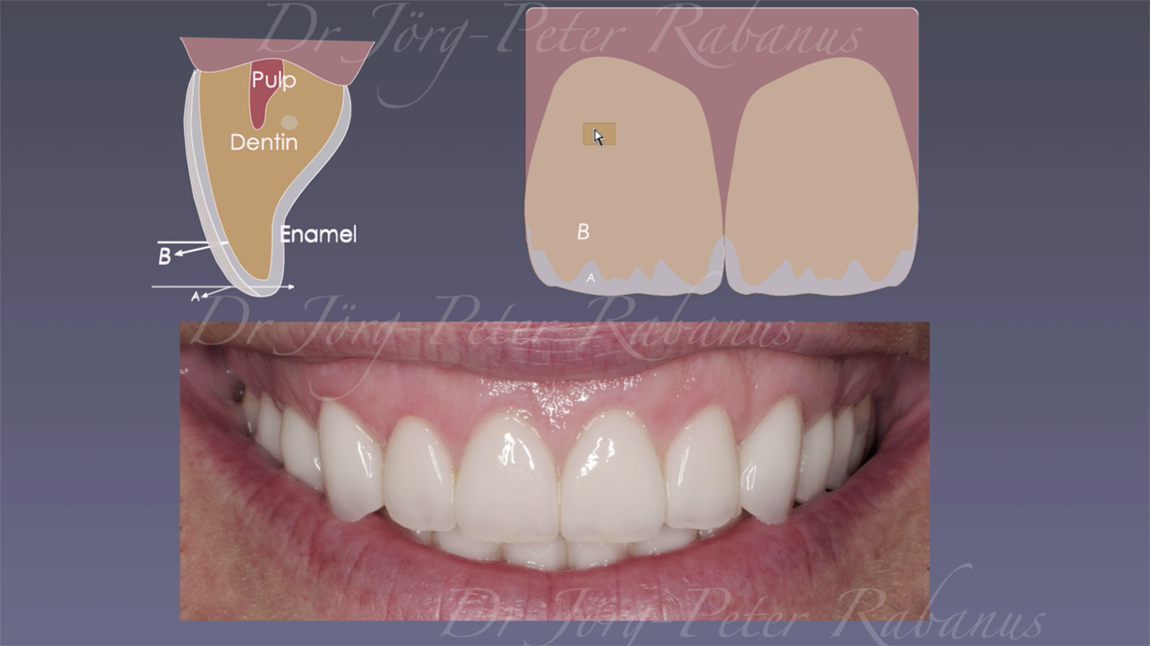Transcript
[Intro Music]
>> Dr. Jörg-Peter Rabanus:
Hi everyone,
You probably found this channel because you were looking for some kind of information about porcelain veneers and cosmetic dentistry.I already have an older channel that covered certain aspects of smile design. I will keep that channel to allow previous visitors to return and watch those videos again in case there are any additional questions.
And attached to this video I will give a link that will allow you to see those videos as well. This channel will be dedicated to the
entire spectrum of cosmetic dentistry. The primary focus will be on porcelain veneers and the dental conditions that can be treated with them.
Each video will cover a particular aspect of smile design.
This first video of this video channel is going to cover the question "How much tooth structure has to be removed to place porcelain veneers?"
I already discussed this question on my other video channel, but it's so important and so frequently asked, that I believe that it's important to start this series with this question again.
To answer the question "How much tooth structure needs to be removed for porcelain veneers?" one has to know "What is the color of the tooth as we find it right now, and what is the color of the future teeth, the desired color of the future teeth. That color difference will be one of the most determining factors when it comes to thickness of porcelain veneers.

We always want to practice minimally invasive dentistry. And so, if we place veneers, ideally, we want to have a veneer that is really thin, is bonded within the enamel of the tooth, and doesn't require much reduction.
So we have the enamel right here. We have the dentin right here, and we have the pulp right her. That's the nerve of the tooth. Placing a thin veneer has a very low risk for inflaming the dental pulp. And the combination of the color of the veneer and the shine-through of the underlying dentin gives us this color at the end. So we have relatively translucent enamel, and light will just through it and gets reflected to only a certain degree.
And then we have the light that goes through and gets reflected on the surface of the dentin, which leads us to the color B that we see here. Color A will be here, and color B will be a combination of the overlying veneer and the underlying dentin that is yellower than it appears on the surface.
In some cases, the dentin is very dark, which leads to darker teeth. The color of the tooth surface is a combination of the dentin, the underlying dentin, which is indicated here and here, and the overlying layers of enamel and porcelain. The darker the dentin the darker is the tooth surface, if the overlying layers stay the same.
One might think that just by placing more opaque porcelain veneers on the surface will handle the problem of dark-appearing teeth. However, as you can see here, the placement of an opaque veneer, in an effort to block away the dark color of underlying dentin, will also remove all natural 3D-effects of a natural and youthful tooth. Hence, this would probably not be the best solution for a patient who has tetracycline-stained teeth or dark teeth for other reasons.
If we want to attain natural and youthful teeth, we will have to eliminate the dark undertone of the dentin while keeping the 3D-effect of the layering of a natural tooth. We can achieve this by, number 1, reducing the tooth more than a lighter appearing tooth. This will allow us to actually block away the dark underlying color more efficiently. In addition, we will apply some layering in the porcelain that will give us the three-dimensional translucency seen at young teeth, such as indicated here, or seen here. At a later stage, I will talk in more detail about the aesthetic elements of youthful and natural-looking teeth.

In order to have additional layers of translucency in this area, we will also have to wrap in the preparation of a tooth here at the incisal edge, and often the reductions are at a range of about 1.5 mm. Having done this will allow light eventually to pass through to create the incisal effects as seen here and here. And because we have reduced the tooth to a greater degree, we will have a similar effect, or we will attain the desired color that we had planned before.
In order to create youthful and natural teeth with even darker dentin, in addition to the layering that I just described to you, we may have to add another opaque basal layer at the base of a porcelain veneer. And this layering would create the same effect. It would give us the color that we are looking for while looking natural.
This concludes the first video of my series about smile design, porcelain veneers, and cosmetic dentistry. If you have any further questions, please send me an E-Mail. You will see a link to this e-mail address attached to this video.
Thank you very much for watching, and
See you soon!
Bye-bye!
[Music]
The following pages discuss the various aspects that make veneers durable and aesthetically pleasing:
Porcelain Veneers: Introduction
Dental Bonding: The crucial element for longivity of dental laminates
Dental Porcelains: What are they?
What makes Porcelain Veneers strong?



